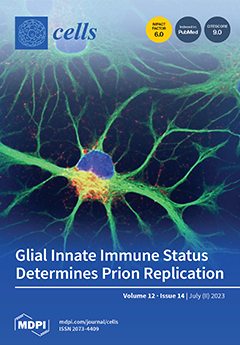K
V channel-interacting proteins (KChIP1-4) belong to a family of Ca
2+-binding EF-hand proteins that are able to bind to the N-terminus of the K
V4 channel α-subunits. KChIPs are predominantly expressed in the brain and heart, where they contribute to
[...] Read more.
K
V channel-interacting proteins (KChIP1-4) belong to a family of Ca
2+-binding EF-hand proteins that are able to bind to the N-terminus of the K
V4 channel α-subunits. KChIPs are predominantly expressed in the brain and heart, where they contribute to the maintenance of the excitability of neurons and cardiomyocytes by modulating the fast inactivating-K
V4 currents. As the auxiliary subunit, KChIPs are critically involved in regulating the surface protein expression and gating properties of K
V4 channels. Mechanistically, KChIP1, KChIP2, and KChIP3 promote the translocation of K
V4 channels to the cell membrane, accelerate voltage-dependent activation, and slow the recovery rate of inactivation, which increases K
V4 currents. By contrast, KChIP4 suppresses K
V4 trafficking and eliminates the fast inactivation of K
V4 currents. In the heart,
IKs,
ICa,L, and
INa can also be regulated by KChIPs.
ICa,L and
INa are positively regulated by KChIP2, whereas
IKs is negatively regulated by KChIP2. Interestingly, KChIP3 is also known as downstream regulatory element antagonist modulator (DREAM) because it can bind directly to the downstream regulatory element (DRE) on the promoters of target genes that are implicated in the regulation of pain, memory, endocrine, immune, and inflammatory reactions. In addition, all the KChIPs can act as transcription factors to repress the expression of genes involved in circadian regulation. Altered expression of KChIPs has been implicated in the pathogenesis of several neurological and cardiovascular diseases. For example, KChIP2 is decreased in failing hearts, while loss of KChIP2 leads to increased susceptibility to arrhythmias. KChIP3 is increased in Alzheimer’s disease and amyotrophic lateral sclerosis, but decreased in epilepsy and Huntington’s disease. In the present review, we summarize the progress of recent studies regarding the structural properties, physiological functions, and pathological roles of KChIPs in both health and disease. We also summarize the small-molecule compounds that regulate the function of KChIPs. This review will provide an overview and update of the regulatory mechanism of the KChIP family and the progress of targeted drug research as a reference for researchers in related fields.
Full article






